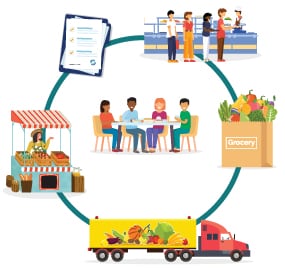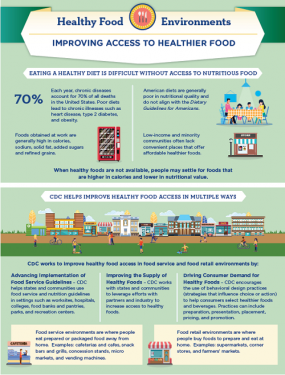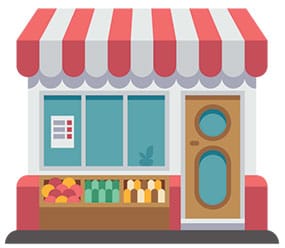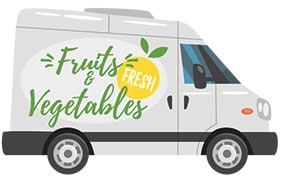Healthy Food Environments: Improving Access to Healthier Food
Eating a healthy diet is difficult without access to nutritious food.
- Each year, chronic diseases account for 70% of all deaths in the United States. Poor diets lead to chronic illnesses such as heart disease, type 2 diabetes, and obesity.
- Foods obtained at work are generally high in calories, sodium, solid fat, added sugars, and refined grains.
- American diets are generally poor in nutritional quality and do not align with the dietary guidelines for Americans.
- Low-income and minority communities often lack convenient places that offer affordable healthier foods.
When healthy foods are not available, people may settle for foods that are higher in calories and lower in nutritional value.
CDC Helps Improve Healthy Food Access in Multiple Ways
CDC works to improve healthy food access in food service and food retail environments by:
- Advancing implementation of food service guidelines – CDC helps states and communities use food service and nutrition guidelines in settings such as worksites, hospitals, colleges, food banks and pantries, parks, and recreation centers.
- Improving the supply of healthy foods – CDC works with states and communities to leverage efforts with partners and industry to increase access to healthy foods.
- Driving consumer demand for healthy foods – CDC encourages the use of behavioral design practices (strategies that influence choice or action) to help consumers select healthier foods and beverages. Practices can include preparation, presentation, placement, pricing, and promotion.
Food service environments are where people eat prepared or packaged food away from home. Examples include cafeterias and cafes, snack bars and grills, concession stands, micro markets, and vending machines.
Food retail environments are where people buy foods to prepare and eat at home. Examples include supermarkets, corner stores, and farmers’ markets.
Increase healthier food offerings in food service venues by:
- Including food service and nutrition guidelines in organizational policies and food contracts.
- Encouraging vendors to procure healthier foods.
- Helping food pantries provide healthier foods.
Connect people to healthier foods by:
- Addressing transportation gaps in communities.
- Supporting farm-to-institution programs.
- Encouraging healthy food choices using behavioral design practices.
Bring partners together to:
- Assist small retailers with purchasing healthy foods at lower costs by using cooperative buying agreements.
- Link local food hubs to organizations that sell or serve food in low-income communities.
- Share how partners overcome barriers to healthy food access.
CDC supports states and communities in these activities through funding, training, and tools.

Los Angeles County, California, requires nutrition standards in food contracts across county departments. This policy impacts an estimated 37 million meals per year.
Navajo nation recruited local clinics and small stores to help implement a fruit and vegetable prescription program. Participants increased their fruit and vegetable consumption by 48%.
Pennsylvania partnered with The Food Trust to improve the stock of healthier foods in over 150 corner stores, which serve 890,000 residents.
Boston, Massachusetts, extended the frequency of fresh truck visits to 5,120 public housing residents from once a month to twice a week and from 2 hours per visit to 3 or 4 hours. Sales of fruits and vegetables increased from $66 per month to $390 per month.








